Grupo 3/Group 3: Josh, Sienna, Mikaela
With a 7:30am start, we marched to the bus, Starbucks knockoff iced coffee (courtesy of OXXO corner store) in hand. We waved goodbye to Villa Purificación and started our journey to Chamela. With a quick stop at Texas To Go gas station, a strangely American name, we were on our way. The bus was mostly silent, aside from some intriguing conversation between Bailey and Clarisa. We drove through clouds of mist and passed a large flock of Black Bellied Whistling Ducks, Wood Storks, and other water dwelling birds. We arrived at the coastal town of La Manzanilla at 10:15am. It’s strange to think that only 52 hours prior we were 2,500 meters above sea level, and now we are being washed over by the smell of salt and the sound of the waves crashing against the shore. For some of us, it was our first time seeing the ocean, and others, their first time seeing the Pacific Ocean. It is also humorous to have been in Mexico for a week before being introduced to the sea.
We visited the mangroves in an area that was fenced off at the edge of town near an estuary. We paid our entrance fees (well Steve did) and then entered. We immediately saw some large American crocodiles. A staff member of this ‘park’ threw filleted fish carcass into the air and it caught in the mouth a prehistoric beast (Jurassic theme song playing in our minds). This was our first introduction to American crocodiles, which we were later informed by Mica Mae that they can weigh up to 800 kilograms. You can distinguish them from alligators by their V-shaped snouts and their ‘evil grin’—sharp teeth gleaming in the sun. Within the mangrove sanctuary where the crocodiles resided we were entertained by the cacophony of squawks of the Great Tailed Grackle, and an astounding number of Egrets, both Snowy and Great alike, and herons (Great Blue, Green, Tri-colored). As we walked through the mangrove trees, iguanas hopped from branch to branch, a surprising agile reptile.
We concluded our experience with drinks and lunch on the beach in a small family-run establishment. The owners were a bit taken aback by the throng. The Pacific Ocean whispered temptingly in our ears as we tried to focus on the debrief. Steve gave us permission to dip our toes in the water, so of course we dipped our whole bodies. While some of us played in the waves, other ordered an overwhelming amount of ceviche and guacamole, and the piña coladas were flowing. The salty water was warm and refreshing, but not a pleasant mouth wash. The beach was busy with gringos, but more importantly, the magnificent frigatebirds, which soared effortlessly above our heads. Other honourable bird mentions were Royal Terns, Caspian Turns, and Heerman’s Gulls.
After some fun in the sun, and definitely no sunburns at all, we continued our drive to Chamela. The landscape outside the bus window was much dryer than that of Las Joyas. During the dry season the trees of Chamela loose their leaves a surprising 180 to the ecosystems of Las Joyas. Do not let the lack of leaves suggest to you that the biodiversity is any less impressive in Chamela. Upon arriving we had already been sorted into our rooms with the assignments creating new roommate pairings! Showers to clean off the salt of the ocean were a welcome sensation.
Steve and Javier took us on a walk down the Eje Central to get us our first up close look at the tropical dry forest. 4 species presentations were done on new species we encountered the: Magnificent Frigatebird by Claire, American Crocodile by Mica Mae, the Gumbo Limbo by Elyse (Bursara sp.) and finally the House Gecko by Sienna! Dinner was chicken tostadas and some sweet guava juice. As we bid goodnight, we were serenaded by the chirping of the Common House Gecko and the white noise of our ceiling fans.
Español
Grupo 3: Josh, Sienna, Mikaela
Salimos a las 7:30am y nos dirigimos al autobús bebiendo un café helado de imitación de Starbucks (cortesía de la tienda OXXO) en la mano. Nos despedimos de Villa Purificación y emprendimos nuestro viaje a Chamela con una breve parada en la gasolinera Texas To Go, un nombre extrañamente estadounidense, luego nos pusimos en camino. El autobús estuvo prácticamente en silencio, salvo por una conversación intrigante entre Bailey y Clarisa. Viajamos entre neblina y pasamos junto a un bordo de agua ocupada por una gran bandada de patos silbadores de vientre negro, cigüeñas de bosque y otras aves acuáticas. Llegamos al pueblo costero de La Manzanilla a las 10:15am. Es extraño pensar que solo 52 horas antes estábamos a 2500 metros sobre el nivel del mar, y ahora nos invade el olor a sal y el sonido de las olas rompiendo contra la orilla costera. Para algunos, era la primera vez que veíamos el océano, y para otros, la primera vez que veían el océano Pacífico. También es curioso haber estado en México durante una semana antes de conocer el mar.
Visitamos los manglares en una zona vallada a las afueras del pueblo, cerca de un estuario. Pagamos la entrada (bueno, Steve lo hizo) e iniciamos el recorrido. Enseguida vimos unos cocodrilos americanos de gran tamaño. Un miembro del personal de este “parque” lanzó al aire un cadáver de pescado fileteado, que atrapó en la boca a una de las bestias prehistóricas (con la canción de Jurassic resonando en nuestra mente). Esta fue nuestra primera experiencia con los cocodrilos americanos, de los que más tarde, según nos informó Mica Mae, pueden pesar hasta 800 kilogramos. Se distinguen de los caimanes por sus hocicos en forma de V y su “sonrisa malvada”: dientes afilados que brillan al sol. Dentro del santuario de manglares, donde residían los cocodrilos, nos entretuvo la cacofonía de graznidos del zanate de cola grande y una asombrosa cantidad de garcetas, tanto níveas como grandes, y garzas (azules, verdes y tricolores). Mientras caminábamos entre los manglares, las iguanas saltaban de rama en rama, un reptil sorprendentemente ágil.
Concluimos nuestra experiencia con unas bebidas y un almuerzo en la playa, en un pequeño establecimiento familiar. Los dueños quedaron un poco desconcertados por la multitud. El Océano Pacífico susurraba tentadoramente en nuestros oídos mientras intentábamos concentrarnos en la sesión informativa. Steve nos dio permiso para mojar los pies, así que, por supuesto, lo hicimos con todo el cuerpo. Mientras algunos jugábamos con las olas, otros pidieron una cantidad abrumadora de ceviche y guacamole, y las piñas coladas no paraban de fluir. El agua de mar estaba tibia y refrescante, pero no era un enjuague bucal agradable. La playa estaba llena de gringos, pero aún más importante, de Fragatas magníficas, que planeaban sin esfuerzo sobre nuestras cabezas. Otras aves presentes fueron los charranes reales, las gaviotas caspias y las gaviotas de Heerman.
Después de divertirnos bajo el sol, y sin ninguna quemadura, continuamos nuestro viaje hacia Chamela. El paisaje desde la ventana del autobús era mucho más seco que el de Las Joyas. Durante la estación seca, los árboles de Chamela pierden sus hojas, un sorprendente cambio de 180 grados, en comparación con los ecosistemas de Las Joyas. No dejen que la falta de hojas les haga pensar que la biodiversidad en Chamela es menos impresionante. Al llegar, ya nos habían asignado nuestras habitaciones, ¡y las asignaciones crearon nuevas parejas! Las duchas para limpiarnos de la sal del mar fueron una grata sensación.
Steve y Javier nos llevaron a caminar por el Eje Central para que pudiéramos observar de cerca el bosque tropical seco. Se realizaron presentaciones sobre cuatro especies nuevas que encontramos: la Fragata Magnífica por Claire, el Cocodrilo Americano por Mica Mae, el Gumbo Limbo por Elyse (Bursara sp.) y, finalmente, el Gecko doméstico por Sienna. La cena consistió en tostadas de pollo y jugo de guayaba dulce. Mientras nos despedíamos, nos deleitó el llamado del gecko doméstico común y el ruido de nuestros ventiladores de techo.
- sleepy baby
- frigatebird
- snowy egret preening
- Mica Mae telling us about American crocodile natural history
- Frigate birds wheeling above the umbrellas at Manzanilla
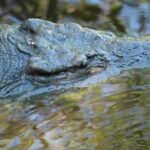
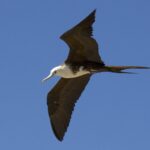
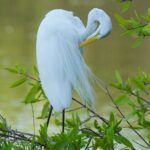
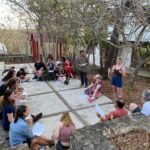
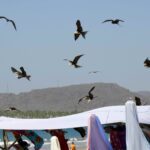
Leave a Reply